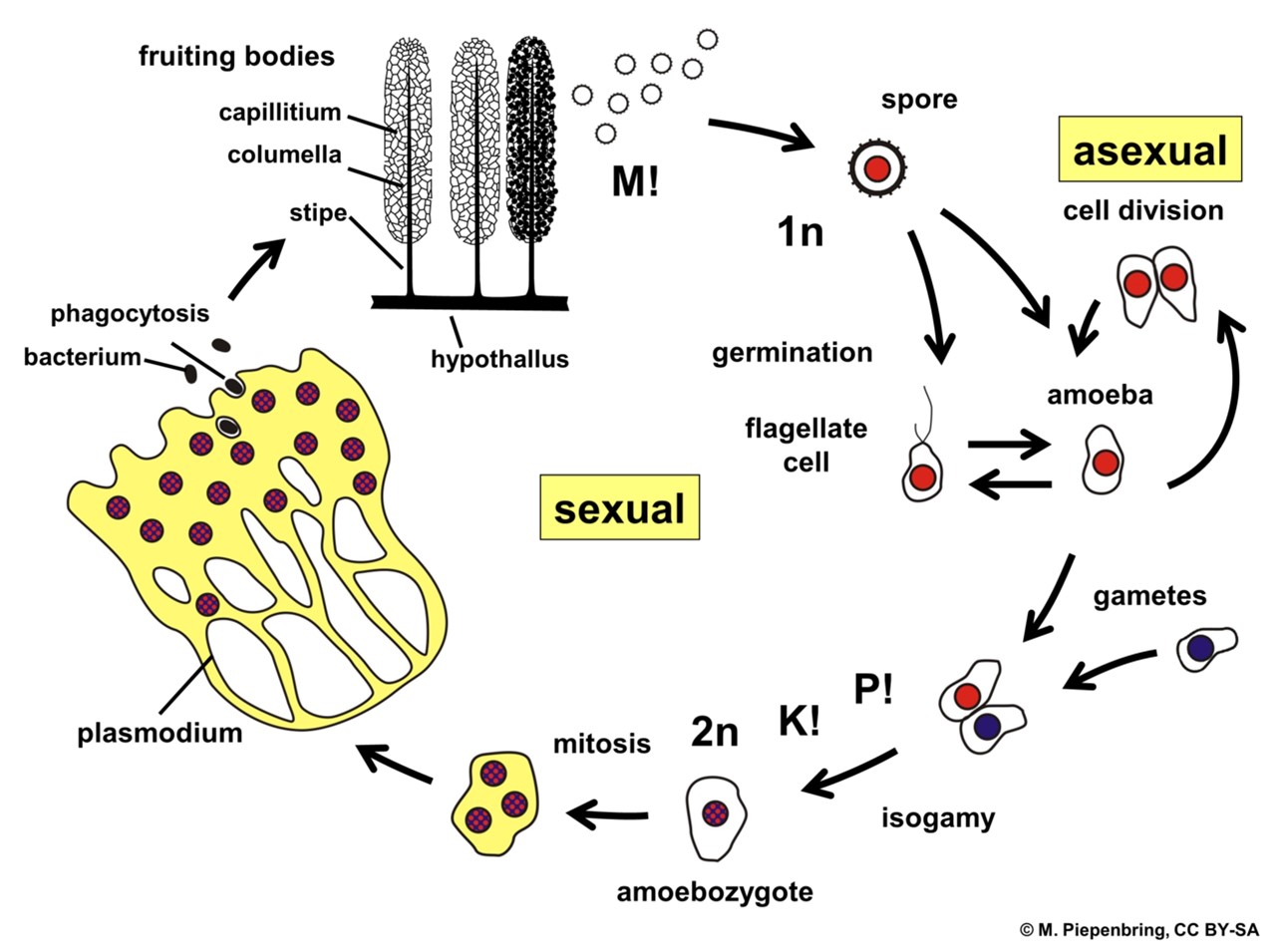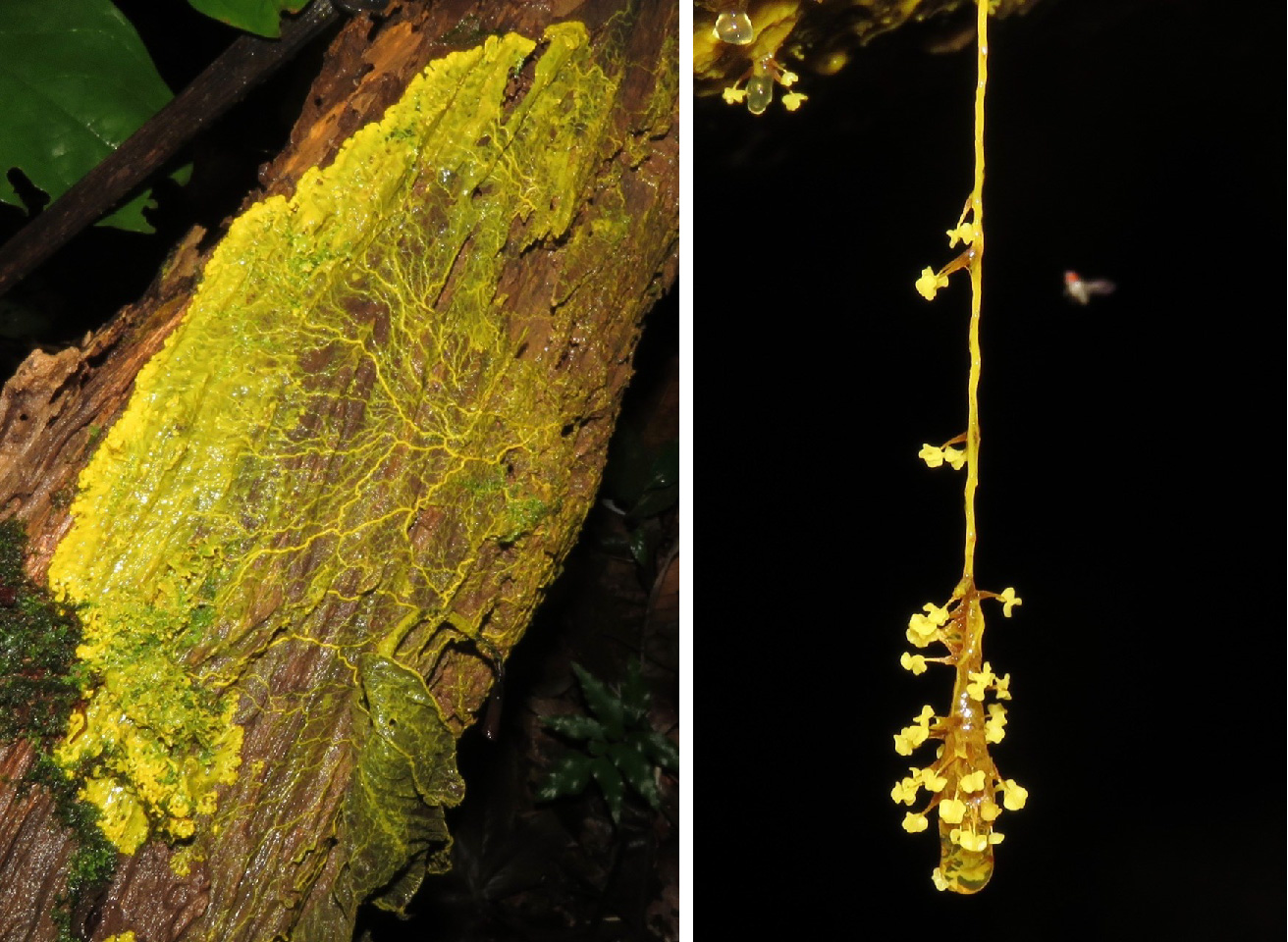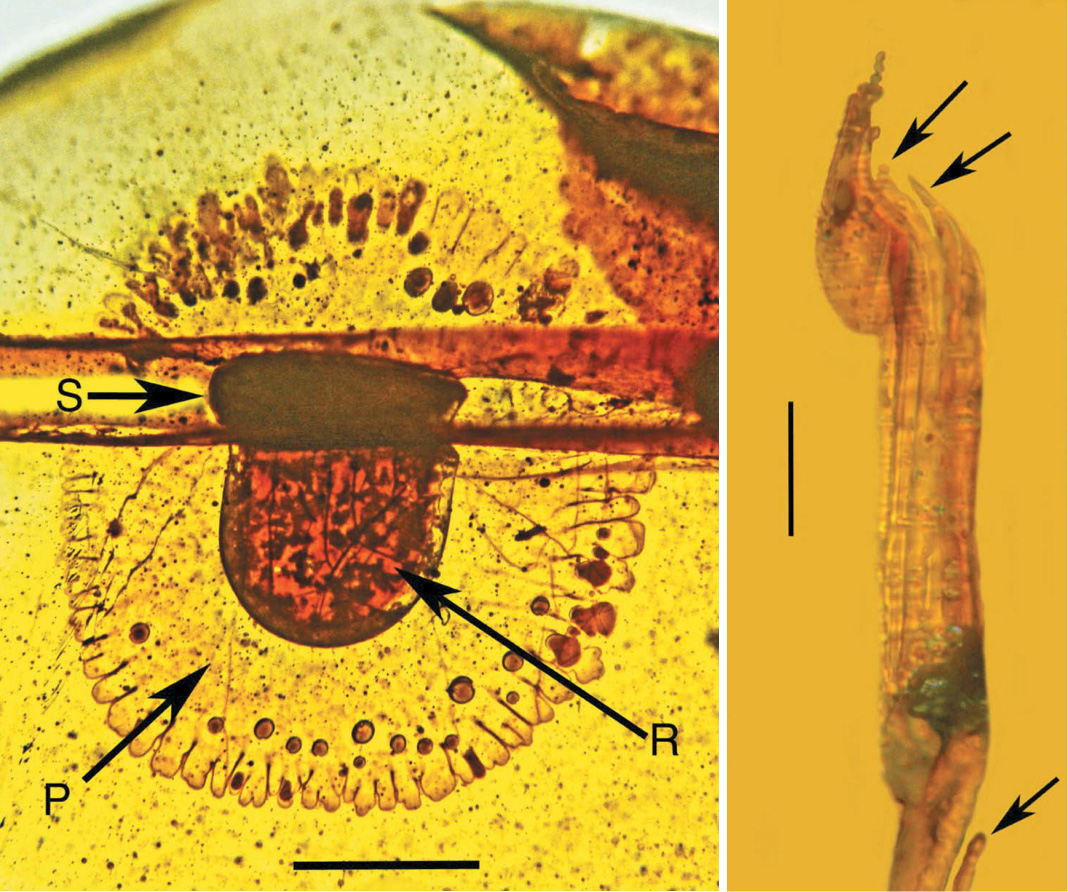
Credit: Tim Tim (VD fr), CC BY-SA 4.0, via Wikimedia Commons
There’s a spooky, otherworldly intelligence on Earth—and it’s called the slime mold! That may sound like a horror movie, but it’s real.
And it grows in leaf litter … perhaps in the woods behind your house, waiting for darkness to creep under your door …
Ok, not that last part. But slime molds can creep and carry out many complex behaviors—all without a brain!
Slime molds aren’t really a mold at all, but a strange mix of animal and fungal characteristics. And they’ve been around for 600 million years. Today, their 900 species separate into two types: plasmodial and cellular slime molds.
The plasmodium begins as a single-celled organism, then starts to divide its nucleus but doesn’t divide cells. The result is sometimes thousands of nuclei living within one huge cell membrane …
Which can grow to several feet across, slither around, grow feet and navigate a maze. It can find food and remember where it found it. It can spread itself into networks, like tree branches or veins, that mimic the most efficiently planned road networks.
Cellular slime molds are multicellular creatures that can shape themselves into sluglike forms and creep across the ground.
When conditions are right, both types can sprout fruiting bodies, similar to mushrooms, which release spores and grow into new slime molds.
Try that on for a Halloween costume!
Background
Synopsis: Slime molds can move, remember how to find food and solve mazes—but they don’t have brains or nervous systems. Despite their name, slime molds are not actually “molds.” They’re a unique group of organisms that exhibit characteristics of both animals and fungi. They have a different kind of intelligence.
- Slime molds were originally thought to be fungi, but molecular studies resulted in their reclassification in Kingdom Protista.
- Like animals, plants, and fungi, slime molds are eukaryotes with cells that contain a nucleus and other organelles within a membrane.
- There are more than 900 species of slime mold, and they have been around for more than 600 million years.
- Slime molds are often found in damp environments such as forests, fields and gardens, especially in leaf litter, rotting wood and soil.
- Slime molds are known for their unique life cycles, which involve a transition between unicellular and multicellular forms.
- Slime molds are interesting to scientists because they exhibit complex behaviors without a nervous system or brain, and they can be used to understand the natural mechanisms of pattern formation, network dynamics and decision-making.
- Two main types of slime molds exist: plasmodial slime molds (or myxomycetes) and cellular slime molds (or dictyostelids).
- Plasmodial slime molds start out as a single cell that undergoes many rounds of mitosis as its nuclei divide repeatedly, but the new nuclei are not separated into individual cells.
- The plasmodium can grow to be several centimeters to meters in size—a single cell containing hundreds to thousands of nuclei.
- All these nuclei coexist within the same cell membrane, communicating and coordinating within the continuous cytoplasm to carry out various functions.

Plasmodial slime mold life cycle. Nuclei are shown in red, black and purple.
Credit: M. Piepenbring, via Wikimedia Commons - The plasmodium can exhibit complex behaviors such as forming footlike pseudopods so it can move to engulf nutrients from decaying organic matter.
- Plasmodia like damp, dark places and are vulnerable to drying out but can survive by forming a hardened mass of dried tissue called a sclerotium that encases the plasmodium until it is rewetted enough to revive.

Glossy-capped sporangia of a Hemitrichia plasmodial slime mold.
Credit: USGS Bee Inventory and Monitoring Lab from Beltsville, Maryland, public domain, via Wikimedia Commons - When conditions are favorable, the plasmodium can form sporangia that produce spores that disperse to produce new individuals.
- Plasmodial slime molds are thought to have evolved from unicellular amoebas that acquired the ability to form multinucleate plasmodia through the process of endosymbiosis, in which one cell lives inside another cell and the two evolve together in a mutually beneficial relationship.
- One type of plasmodial slime mold that is particularly interesting to researchers is Physarum polycephalum.

Left: Physarum polycephalum on a log.
Right: Fruiting bodies and sporification of P. polycephalum.
Credit: Rich Hoyer, via Wikimedia Commons- Scientists can manipulate this species because it especially loves the bacteria that grow on oats, so it seeks out oat flakes and sugar.
- It navigates using chemotaxis, moving in response to chemical gradients.
- In 2000, scientists experimented with this slime mold in a maze. First it filled the entire maze, then identified the two food sources and reorganized its body to concentrate its mass closest to the food, with the thinnest possible connection along the most efficient path between the food sources.

The Physarum polycephalum (yellow) explored and filled the maze (left). When the researchers placed sugar (red) at two separate points, the mold concentrated most of its mass there and left only the most efficient connection between the two points.
Credit: Philcha, public domain, via Wikimedia Commons - P. polycephalum can remember where it previously found food, because when it comes into contact with food it releases a substance that softens the gel-like walls of the pseudopod near the food source, widening the tube to record the location even after the food is gone.
- It has evolved to efficiently transport nutrients from one place to another, so it can rapidly work out the most efficient paths between destinations. This ability is of interest to transportation engineers.
- When presented with oat flakes organized in the pattern of population centers around Tokyo, the slime mold built a map resembling the highly efficient Tokyo rail system in just 26 hours.
- When presented with food arranged like the 20 major population centers in the United States, the slime mold produced a result resembling the United States interstate system. The same experiment was undertaken for different countries with similar results.
- Of course, the highway systems and rail systems helped to determine the key population centers, but the slime mold could optimize routes in a matter of days.
- You have probably seen another type of plasmodial slime mold that is common in household gardens.
- Dog vomit slime mold develops on bark mulch when the mulch is soaked after heavy rain or excessive watering.

Fuligo septica occurs all over the world, especially on bark mulch, and is known as scrambled egg slime, dog vomit slime or jasmine mold.
Credit: Siga, public domain, via Wikimedia Commons
- Dog vomit slime mold develops on bark mulch when the mulch is soaked after heavy rain or excessive watering.
- The other main type of slime molds, the cellular slime molds, exist as individual cells that feed on microbes but can aggregate to form multicellular mobile structures called pseudoplasmodia (or “slugs”) when conditions become unfavorable to individual living.
- These multicellular slugs can slowly crawl across a substrate, eventually forming fruiting bodies called sorocarps that produce spores that disperse and germinate to form individual cells, beginning the cycle again.
- Slime molds that launched spores among the dinosaurs have been found complete with their slugs and fruiting bodies preserved in 98.8-million-year-old Upper Cretaceous amber from Myanmar.

Left: This fossil of an extinct slime mold, Paleoplastes burmanica, is preserved in 98.8-million-year-old amber from Myanmar. Legend: P = plasmodium, R = pseudoplasmodium (reddish) and S = developing fruiting bodies called sorocarps. Scale bar = 840 μm.
Right: Fruiting sorocarps of P. burmanica in amber from Myanmar. The one at the top has a bulbous base with a narrow tip from which a chain of spores has emerged. Three others (arrows) have simple tips. Scale bar = 34 μm.
Credit: USDA
- If you want to kill slime mold (but who would want to do that to this amazing organism?) you can use baking soda, potassium bicarbonate, cornmeal, cornmeal tea or hydrogen peroxide.

